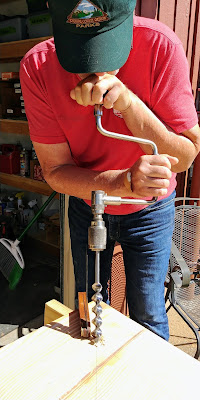I have always admired the native american practice of using every part of an animal they killed. We americans generate entirely too much waste. So when it comes to woodworking, I try hard to avoid any waste at all, which is actually quite easy.
The slab I purchased was 11' long and I used 8' of it for the table, so that left a piece 40" wide and about 36" long. That piece didn't look right for anything as it was and it had two big knots in the flat sawn center, so I decided to rip it into two pieces, cutting out a small center section.
The near piece is clear vertical grain and I haven't decided what to do with it yet. The rear piece has a knot and a limb coming off the side of it, which makes is quite interesting. It is also angled, reflecting the way the tree was cut. It had one large crack running all the way through it which needed to be repaired with epoxy. I taped the bottom of it and then filled it from the top.
I learned the hard way that you have to overfill cracks by quite a bit. Even then, I ended up having to fill the crack a second time about an hour after the first time. T-88 epoxy takes a long time to set up so it was uncured.
Smoothing the epoxy isn't as bad as you might think. I've found that a plane works just fine:
I wanted rustic legs from small logs that would be attached with loose round tenons so I used a technique that I have used successfully with three-legged stools but never with four legs. I created a 45 degree sight line and used a bevel gauge to guide a brace and bit.
This doesn't seem like it could possibly work, but it does. The four legs were all within 1/4" first try.
Here is the final result:







I think I would have used butterfly keys on the crack. Something I've seen done numerous times but still haven't tried to do.
ReplyDeleteRalph,
ReplyDeleteI agree that butterfly keys would have been a good idea, and I almost put two on the bottom. The epoxy seemed so strong that I decided not to. Time will tell.
Very nice and good use of left overs!
ReplyDelete